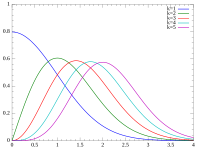Chi distribution

The chi distribution is like a lottery ticket. It tells you the probabilities of how often an event will happen. It is named after the Greek letter chi, which stands for “chance.” The chi distribution is used in statistics to measure whether an observed occurrence is due to chance. For example, if you flip a coin 10 times and get heads six times, then you might use a chi distribution to figure out how likely it is that the result was due to chance. You would look at the probability that the coin is fair (50%) and compare it to the probability of the result you actually got (6 out of 10) to determine the probability that the result is due to chance.
